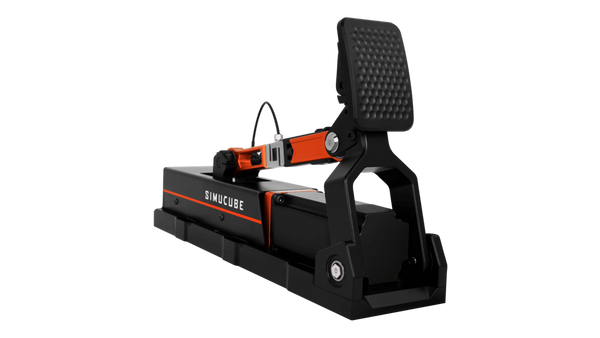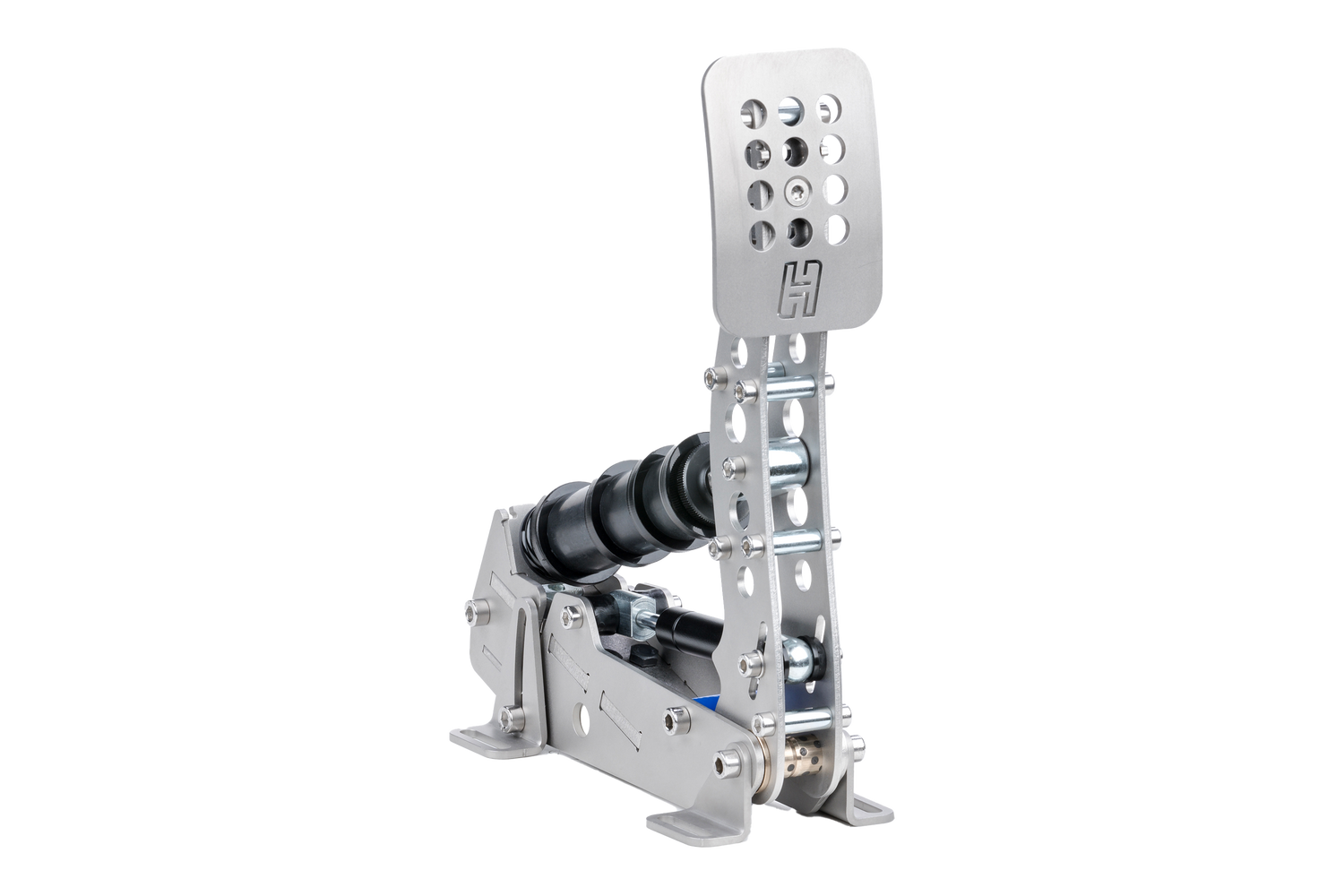"Pedals? Why do I need that when I have my controller?"
It’s been a while since we posted anything regarding sim racing and we are back to discussing matters close to every sim racing driver’s heart.
Slowing down
Wait, what?! Since when slowing down should be close to my sim racing heart?
That’s something we will discuss today and explain in detail why it is the most important thing out of everything that you do.
There is this saying that straights are for fast cars, but corners are for fast drivers. Anyone can press a throttle and keep it pinned on straights. You could put a cinder block on your throttle and get the same result. Of course we are talking about straights here. At apexes and exits things don’t get so straightforward anymore but more on that later.
First we need to focus on braking and why it matters so much to get the speed out of the car.

99% of cars that have ever raced had 4 rubber tires (Why 99%? Because we had few wild concepts with more than 4 tires and they actually raced that) and your job as a driver is to keep them on the tarmac. That’s what a safe driver does, but a fast one knows that those 4 rubber rings are capable of reaching a certain threshold of adhesion which revolves around creating friction between two different surfaces. A fast driver knows how to reach a point where that friction is maximized but never exceeded.
When you are braking you are squeezing a brake disk with a brake pad using hydraulic pistons to grab that disk and force it to stop at the maximum possible potential and what differentiates good driver from an excellent one is the ability to almost have this 6th sense how much pressure, for how long and of course when exactly needs to be applied to get maximum stopping power without locking up or missing your points on track.
There are people who are capable of getting near that limit on every track, using any car and any hardware given enough time of course. However most people are not as gifted and that’s where the importance of having a great set of pedals that are also beautifully calibrated to your preference and needs.
So how do I know what is needed for best results
I am sure you guys heard about brakes that give you great sense of pressure, giving you good feedback on your input and almost always such attributes are associated with load cell that have got rubber/polyurethane bushings or hydraulic with springs or bushings.
Why is that they usually come up in conversations when people discuss good braking feel and therefore performance? Is it possible to be really good and fast using cheaper potentiometer based pedals? Short answer is: Yes. Long answer is: It depends on many factors.

Your input on both the throttle and brake pedal are crucial for your enjoyment and performance and if you are not an alien who has a brain programmed to be fast no matter what he/she is given, you need to get good, positive feedback from your pedals because otherwise your brain can’t figure out what to do to progress.

Biggest difference between low end potentiometer pedals vs high end load cell pedal sets is transition from travel based readout for digital signal used by a simulation to the pressure based readout.
Human brain has a much easier time figuring out how much force certain tasks require than how much distance they need to cover to do something. That’s why we don’t spill our coffees in the morning, no matter how sleepy we are, when we lift a cup of coffee. Our brain simply knows how much force you need to use to operate things.
This is exactly the same story with pedals. When you can calibrate yourself to use a certain amount of pressure from your legs to achieve desired effect like maximizing stopping force and minimizing stopping distance, you end up without any wheel lock-ups and maximum time gained in each braking zone.

However high end pedals are not just good for braking and accelerating efficiently. The best lesson you can learn is that your brake pedal is not just for slowing the car down but also for adjusting the handling and overall balance of your car. Imagine you are in a corner that because of its radius, how it is angled (cambered) etc can be exceptionally tricky to get your car rotated (car’s willingness to turn) and that’s because your front axle lacks load to push the tires down onto a track and give you more grip.

Last few meters of brake pressure is there to help the car rotate
Applying some brake pressure in such situations shifts the load distribution more towards the front and you gain a car that is far more willing to rotate and that means you can accelerate harder and sooner than you would have if you haven’t used your brake pedal for that.
The biggest problem here is that to actually gain from doing that and not lose you need very little amount of brake pressure because your goal is to shift load, not slow down a car by a lot. Unfortunately that’s something a lower end pedals are more vague about because you rely on pedal travel and it is fairly easy to not go far enough or usually more common too far and you end up losing time instead of gaining. While a good set of pedals which is also calibrated and your brain in synchronized with it gives you the ability to apply micro corrections to your pressure and apply a very precise amount of force needed to get what you need.

Why is being so precise so important? Tires, even the virtual ones, are based on data that tells the simulation how much energy can a tire “handle” before it gives up and there is a finite amount of that energy which works in all directions. If you brake hard, you have less grip for turning, if you turn, you rob your tires out of braking potential and that’s why having a very precise set of pedals which you can control with utmost confidence and finesse gives you far greater control and that increases the ceiling for the pace.

Red line - brake pressure. Green - throttle. First braking zone shows how it goes down then up and down again. Showing micro adjustments of braking pressure needed to get the most out of a braking zone
We sort of neglected the throttle pedal in our newest blog and that’s mostly due to how extremely important the brake pedal is compared to the throttle. With throttle it is easier to get in tune with as there are less rules to follow to be efficient and fast. You want to treat a throttle pedal like a scale, not an off/on switch so never go from 0% to 100% by smashing your right foot on the accelerator. Better pedals help with that however it’s not as crucial as with brakes. The second and last rule is that it is always better to be late with your throttle application than too early. If you end up in a situation where you need to back off your throttle by a significant amount and not just a little, it means you most likely started accelerating too early, too hard or sometimes even both.
 Newest developments by manufacturers like Granite Devices, makers of Simucube 2 bases and wheels have also entered the world of pedals.
Newest developments by manufacturers like Granite Devices, makers of Simucube 2 bases and wheels have also entered the world of pedals.
Their offering is very unique because they are potentially first ever commercially available active pedals which can translate forces coming from a sim directly to your feet with almost ininite customizability options. For decades, ever since driving games bacame a thing, feeling anything with your feet was the goal that everyone dreamt about.

These pedals can be set up to act how you want them to act as a throttle pedal and brake pedal and send you feedback on what is going on with a car. Feeling of ABS kicking, traction control engaging can be extremely helpful to determine how close to limit you really are.
Wrap up
Following these instructions can help you no matter what sort of pedals you own but if you also get high end pedals, after some time adjusting your brain to the new feeling, they will reward you handsomely. Sim racing will never be the same again because once you start to understand where the speed can be extracted from it becomes an addiction to find more and more performance from finetuning your style and hardware to get the most out of the whole package.

Get your high end racing pedals now and enjoy sim racing like you have never before!
https://trakracer.com/collections/pedals
https://trakracer.com.au/collections/electronics/pedals
https://trakracer.eu/collections/electronics/pedals
https://trakracer.co.uk/collections/electronics/pedalsTake care and see you again when we will discuss more sim racing related stuff!
Yours sincerely,
Trak Racer Team


Leave a comment
All comments are moderated before being published.
This site is protected by hCaptcha and the hCaptcha Privacy Policy and Terms of Service apply.